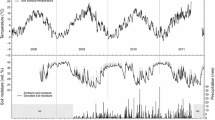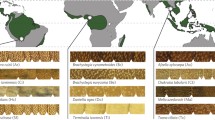Abstract
We enriched in CO2 the canopy of 14 broad-leaved trees in a species-rich, ca. 30-m-tall forest in NW Switzerland to test whether elevated CO2 reduces water use in mature forest trees. Measurements of sap flux density (J S) were made prior to CO2 enrichment (summer 2000) and throughout the first whole growing season of CO2 exposure (2001) using the constant heat-flow technique. The short-term responses of sap flux to brief (1.5–3 h) interruptions of CO2 enrichment were also examined. There were no significant a priori differences in morphological and physiological traits between trees which were later exposed to elevated CO2 (n=14) and trees later used as controls (n=19). Over the entire growing season, CO2 enrichment resulted in an average 10.7% reduction in mean daily J S across all species compared to control trees. Responses were most pronounced in Carpinus, Acer, Prunus and Tilia, smaller in Quercus and close to zero in Fagus trees. The J S of treated trees significantly increased by 7% upon transient exposure to ambient CO2 concentrations at noon. Hence, responses of the different species were, in the short term, similar in magnitude to those observed over the whole season (though opposite because of the reversed treatment). The reductions in mean J S of CO2-enriched trees were high (22%) under conditions of low evaporative demand (vapour pressure deficit, VPD <5 hPa) and small (2%) when mean daily VPD was greater than 10 hPa. During a relatively dry period, the effect of elevated CO2 on J S even appeared to be reversed. These results suggest that daily water savings by CO2-enriched trees may have accumulated to a significantly improved water status by the time when control trees were short of soil moisture. Our data indicate that the magnitude of CO2 effects on stand transpiration will depend on rainfall regimes and the relative abundance of the different species, being more pronounced under humid conditions and in stands dominated by species such as Carpinus and negligible in mono-specific Fagus forests.








Similar content being viewed by others
References
Amthor JS (1995) Terrestrial higher-plant response to increasing atmospheric [CO2] in relation to the global carbon cycle. Global Change Biol 1:243–274
Barton CVM, Jarvis PG (1999) Growth response of branches of Picea sitchensis to four years exposure to elevated atmospheric carbon dioxide concentration. New Phytol 144:233–243
Bunce JA (1992) Stomatal conductance, photosynthesis and respiration of temperate deciduous tree seedlings grown outdoors at an elevated concentration of carbon dioxide. Plant Cell Environ 15:541–549
Clearwater MJ, Meinzer FC, Andrade JL, Goldstein G, Holbrook NM (1999) Potential errors in measurement of nonuniform sap flow using heat dissipation probes. Tree Physiol 19:681–687
Dixon M, Le Thiec D, Garrec JP (1995) The growth and gas exchange responses of soil-planted Norway spruce [Picea abies (L.) Karst.] and red oak (Quercus rubra L.) exposed to elevated CO2 and to naturally occurring drought. New Phytol 129:265–273
Dufrêne E, Pontailler JY, Saugier B (1993) A branch bag technique for simultaneous CO2 enrichment and assimilation measurements on beech (Fagus sylvatica L). Plant Cell Environ 16:1131–1138
Ellsworth DS (1999) CO2 enrichment in a maturing pine forest: are CO2 exchange and water status in the canopy affected? Plant Cell Environ 22:461–472
Ellsworth DS, Oren R, Huang C, Phillips N, Hendrey GR (1995) Leaf and canopy responses to elevated CO2 in a pine forest under free-air CO2 enrichment. Oecologia 104:139–146
Field CB, Jackson RB, Mooney HA (1995) Stomatal responses to increased CO2—implications from the plant to the global-scale. Plant Cell Environ 18:1214–1225
Gielen B, Calfapietra C, Sabatti M, Ceulemans R (2001) Leaf area dynamics in a closed poplar plantation under free-air carbon dioxide enrichment. Tree Physiol 21:1245–1255
Granier A (1985) A new method of sap flow measurement in tree stems. Ann Sci For 42:193–200
Granier A (1987) Evaluation of transpiration in a Douglas fir stand by means of sap flow measurements. Tree Physiol 3:309–320
Hättenschwiler S, Miglietta F, Raschi A, Körner C (1997) Morphological adjustments of mature Quercus ilex trees to elevated CO2. Acta Oecol 18:361–365
Heath J (1998) Stomata of trees growing in CO2-enriched air show reduced sensitivity to vapour pressure deficit and drought. Plant Cell Environ 21:1077–1088
Herbst M (1995) Stomatal behaviour in a beech canopy: an analysis of Bowen ratio measurements compared with porometer data. Plant Cell Environ 18:1010–1018
Hungate BA, Reichstein M, Dijkstra P, Johnson D, Hymus G, Tenhunen JD, Hinkle CR, Drake BG (2002) Evapotranspiration and soil water content in a scrub-oak woodland under carbon dioxide enrichment. Global Change Biol 8:289–298
Jarvis PG, McNaughton KG (1986) Stomatal control of transpiration: scaling up from leaf to region. Adv Ecol Res 15:1–49
Jimenez MS, Cermak J, Kucera J, Morales D (1996) Laurel forests in Tenerife, Canary Islands: The annual course of sap flow in Laurus trees and stand. J Hydrol 183:307–321
Jones MB, Brown JC, Raschi A, Miglietta F (1995) The effects on Arbutus unedo L. of long-term exposure to elevated CO2. Global Change Biol 1:295–302
Kellomäki S, Wang KY (1998) Sap flow in Scots pines growing under conditions of year-round carbon dioxide enrichment and temperature elevation. Plant Cell Environ 21:969–981
Knapp AK, Hamerlynck EP, Ham JM, Owensby CE (1996) Responses in stomatal conductance to elevated CO2 in 12 grassland species that differ in growth form. Vegetatio 125:31–41
Körner C, Arnone JA III (1992) Responses to elevated carbon dioxide in artificial tropical ecosystems. Science 257:1672–1675
Köstner BMM, Granier A, Cermak J (1998) Sapflow measurements in forest stands: methods and uncertainties. Ann Sci For 55:13–27
Linsbauer K (1916) Beiträge zur Kenntnis der Spaltöffnungsbewegung. Flora 9:100–143
Lodge RJ, Dijkstra P, Drake BG, Morison JIL (2001) Stomatal acclimation to increased CO2 concentration in a Florida scrub oak species Quercus myrtifolia Willd. Plant Cell Environ 24:77–88
Lu P (1997) A direct method for estimating the average sap flux density using a modified Granier measuring system. Aust J Plant Physiol 24:701–705
Lu P, Muller WJ, Chacko EK (2000) Spatial variations in xylem sap flux density in the trunk of orchard-grown, mature mango trees under changing soil water conditions. Tree Physiol 20:683–692
Medlyn BE, Barton CVM, Broadmeadow MSJ, Ceulemans R, De Angelis P, Forstreuter M, Freeman M, Jackson SB, Kellomäki S, Laitat E, Rey A, Roberntz P, Sigurdsson BD, Strassemeyer J, Wang K, Curtis PS, Jarvis PG (2001) Stomatal conductance of forest species after long-term exposure to elevated CO2 concentration: a synthesis. New Phytol 149:247–264
Neter J, Kutner MH, Nachtsheim CJ, Wassermann W (1996) Applied linear statistical methods, 4th edn. McGraw-Hill, Boston
Niklaus PA, Spinnler D, Körner C (1998) Soil moisture dynamics of calcareous grassland under elevated CO2. Oecologia 117:201–208
Norby RJ, Wullschleger SD, Gunderson CA, Johnson DW, Ceulemans R (1999) Tree responses to rising CO2 in field experiments: implications for the future. Plant Cell Environ 22:683–714
Norby RJ, Todd DE, Fults J, Johnson DW (2001) Allometric determination of tree growth in a CO2-enriched sweetgum stand. New Phytol 150:477–487
Pepin S, Körner C (2002) web-FACE: a new canopy free-air CO2 enrichment system for tall trees in mature forests. Oecologia 133:1–9
Phillips N, Oren R (2001) Intra- and inter-annual variation in transpiration of a pine forest. Ecol Appl 11:385–396
Picon C, Guehl JM, Ferhi A (1996) Leaf gas exchange and carbon isotope composition responses to drought in a drought-avoiding (Pinus pinaster) and a drought-tolerant (Quercus petraea) species under present and elevated CO2 concentrations. Plant Cell Environ 19:182–190
Roberntz P, Stockfors J (1998) Effects of elevated CO2 concentration and nutrition on net photosynthesis, stomatal conductance and needle respiration of field-grown Norway spruce trees. Tree Physiol 18:233–241
Saxe H, Ellsworth DS, Heath J (1998) Tree and forest functioning in an enriched CO2 atmosphere. New Phytol 139:395–436
Schäfer KVR, Oren R, Lai C-T, Katul GG (2002) Hydrologic balance in an intact temperate forest ecosystem under ambient and elevated atmospheric CO2 concentration. Global Change Biol 8:895–911
Teskey RO (1995) A field study of the effects of elevated CO2 on carbon assimilation, stomatal conductance and leaf and branch growth of Pinus taeda trees. Plant Cell Environ 18:565–573
Tognetti R, Longobucco A, Miglietta F, Raschi A (1998) Transpiration and stomatal behaviour of Quercus ilex plants during the summer in a Mediterranean carbon dioxide spring. Plant Cell Environ 21:613–622
Tognetti R, Longobucco A, Miglietta F, Raschi A (1999) Water relations, stomatal response and transpiration of Quercus pubescens trees during summer in a Mediterranean carbon dioxide spring. Tree Physiol 19:261–270
Volk M, Niklaus PA, Körner C (2000) Soil moisture effects determine CO2 responses of grassland species. Oecologia 125:380–388
Wand SJE, Midgley GF, Jones MH, Curtis PS (1999) Responses of wild C4 and C3 grass (Poaceae) species to elevated atmospheric CO2 concentration: a meta-analytic test of current theories and perceptions. Global Change Biol 5:723–741
Will RE, Teskey RO (1997) Effect of irradiance and vapour pressure deficit on stomatal response to CO2 enrichment of four tree species. J Exp Bot 48:2095–2102
Wilson KB, Carlson TN, Bunce JA (1999) Feedback significantly influences the simulated effect of CO2 on seasonal evapotranspiration from two agricultural species. Global Change Biol 5:903–917
Wong SC, Dunin FX (1987) Photosynthesis and transpiration of trees in a Eucalypt forest stand: CO2, light and humidity responses. Aust J Plant Physiol 14:619–632
Woodward FI, Thompson GB, McKee IF (1991) The effect of elevated concentrations of carbon dioxide on individual plants, populations, communities and ecosystems. Ann Bot 67:23–38
Wullschleger SD, Norby RJ (2001) Sap velocity and canopy transpiration in a sweetgum stand exposed to free-air CO2 enrichment (FACE). New Phytol 150:489–498
Wullschleger SD, Meinzer FC, Vertessy RA (1998) A review of whole-plant water use studies in trees. Tree Physiol 18:499–512
Wullschleger SD, Gunderson CA, Hanson PJ, Wilson KB, Norby RJ (2002) Sensitivity of stomatal and canopy conductances to elevated CO2 concentration—interacting variables and perspectives of scale. New Phytol 153:485–496
Acknowledgements
We thank Dieter Spinnler, Günter Hoch and Eric Jüdin for helpful suggestions concerning statistical issues, Rolf Siegwolf (Paul Scherrer Institute Stable Isotope Facility) for isotope analysis and valuable discussion, and two anonymous reviewers for their constructive comments, which greatly improved this manuscript. This research was supported by the Swiss National Science Foundation (grant 3100–059769.99). The crane was sponsored by the Swiss Federal Office of the Environment (BUWAL) and the University of Basel.
Author information
Authors and Affiliations
Corresponding author
Rights and permissions
About this article
Cite this article
Cech, P.G., Pepin, S. & Körner, C. Elevated CO2 reduces sap flux in mature deciduous forest trees. Oecologia 137, 258–268 (2003). https://doi.org/10.1007/s00442-003-1348-7
Received:
Accepted:
Published:
Issue Date:
DOI: https://doi.org/10.1007/s00442-003-1348-7




